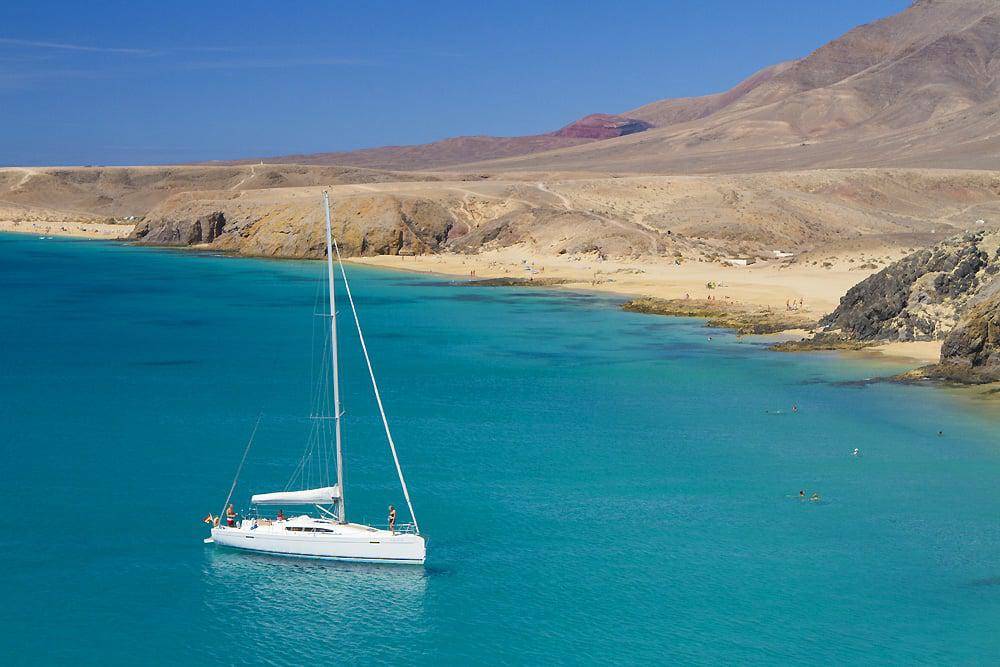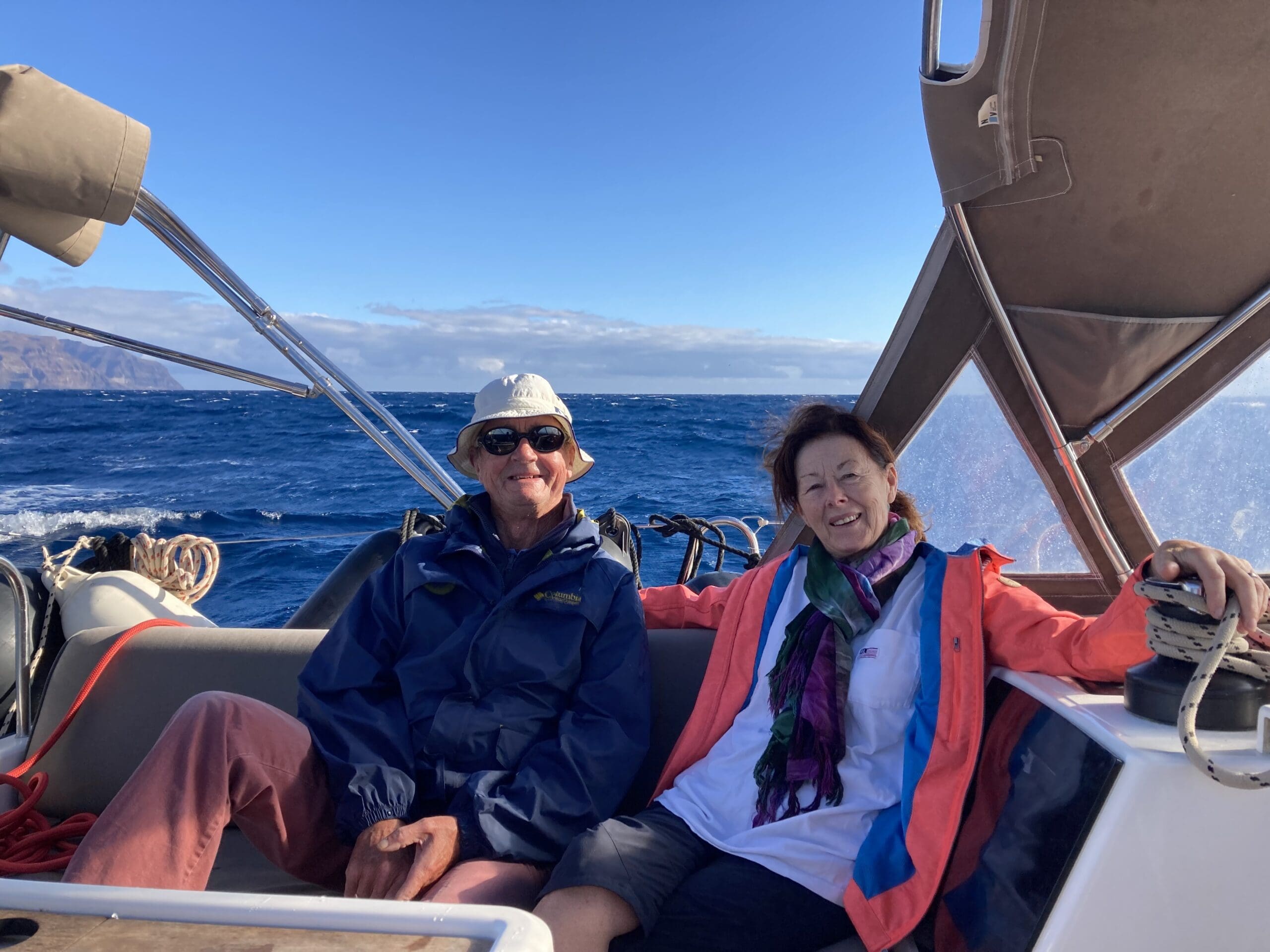by Neil Hegarty
Anne Kenny and I arrived at Marina Lanzarote on Thursday 23rd of June. I think, maybe because of our age, Lava Charter were surprised that we had booked off-season. At this time of the year the wind can be quite fresh. We chartered a Dufour 382 Grand Large called Tortuga expecting it to be somewhat like my Dufour 34 Shelduck which it was, even though 14 years younger. For Anne and me it was 4 years since our last Atlantic passage, for the OCC pursuit event from Galicia to the Azores. I was a little apprehensive as we boarded, what seemed to me to be, a large, complicated yacht with two wheels and a great beam. I soon settled in as if I was about to get back on my bicycle to enjoy some of the advantages of sailing off-season in the Canary Islands with their easy access to marina berths. I was happy not to have to spend nights at anchor, in a chartered yacht, in strong gusty winds.

Saturday 25th
Mary and Len Curtin were invited to join the cruise and they arrived at 11.00 after an early start in Cork. We immediately went to a French run café at the marina enjoying an excellent breakfast. Anne and Mary then headed off to provision Tortuga while Len and I were shown it’s workings by the Lava skipper Jan, who if you chose, could also be hired to sail aboard.
Sunday 26th
My plan was to sail the 250 miles to Santa Cruz on Isla De La Palma having two nights at sea and to avoid the acceleration zones. The idea being to sail to the far point of the cruise first and then work our way back. I may have been somewhat over ambitious. Tortuga departed the marina at 06.00, motored in the lee of Isla De Lanzarote and we set sails near Point Papagayo at the Southwestern tip of the island. I took in one reef and as it turned out we may have been more comfortable with two. It was wonderful reaching in 15 to 20 knots of wind until 17.00 when the wind went to 25 knots, so we took off the headsail and things quietened down. At 19.00 while sitting alone in the cockpit in sunshine too far from the sprayhood I took the first soaking. Tortuga is a fast yacht, and it was about then I began to wonder if we would arrive off Santa Cruz La Palma in darkness.
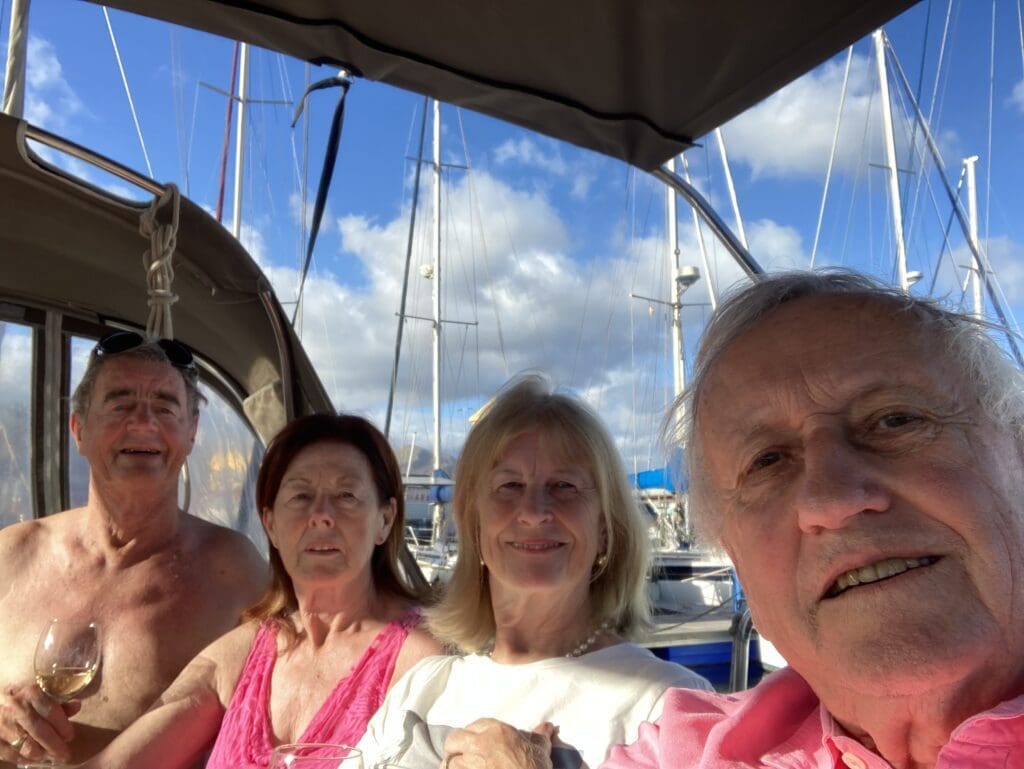
Monday 27th.
Mary and Len took the midnight to 04.00 watch. Soon after, Anne and I came on watch and we noticed a strong white light to the north of Point de Anaga on the northerly tip of Tenerife. As those aboard thought we were sailing too near they called to us up on the radio to stay clear. It turned out to be a rig doing scientific research. I calculated then that at the speed Tortuga was doing towards La Palma, we would probably have arrived in darkness. The chart plotter was awkwardly positioned, for someone with old knees, low down on the end of the cockpit table. I was therefore depending on Navionics charts on my iPhone for entering harbours in darkness and was afraid of running out of charge. At this time, I had not yet realised that there was one phone charger near the radio that allowed phone charging at sea. By then I was also missing the comfort of a chart table.
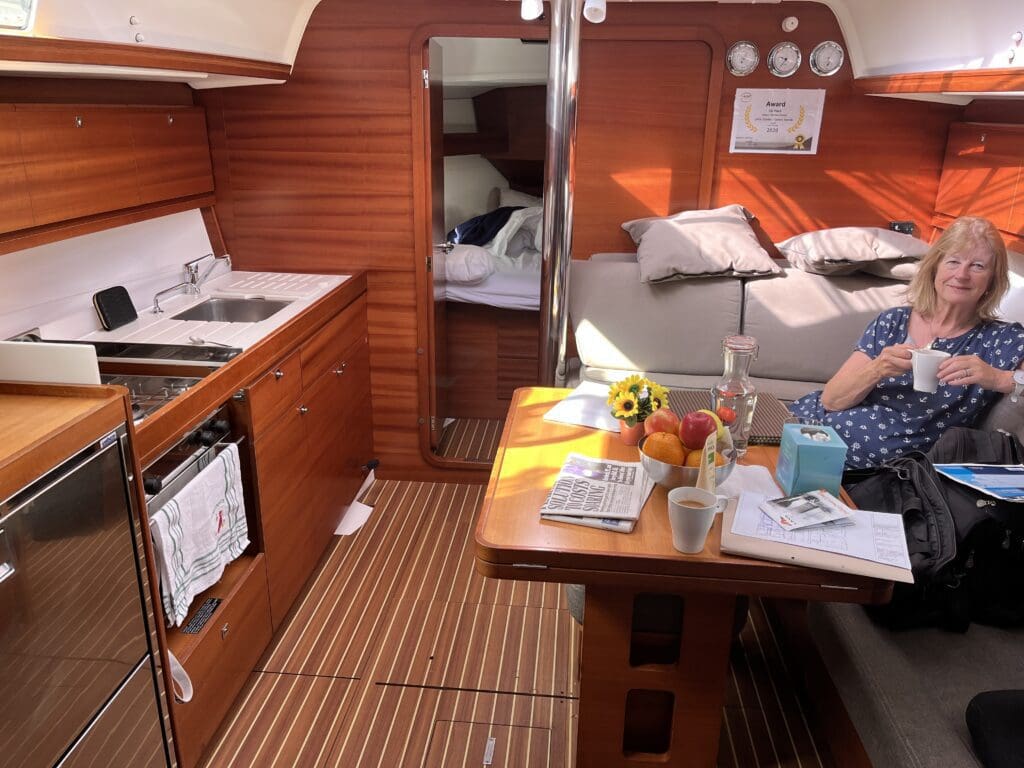
At 07.00 I called Len and Mary to help us tack round and we agreed we would head for Santa Cruz Tenerife. It is very confusing having two cities with the same name on nearby islands. All hands made a great job of reducing sail in the dawn light with Len being the one who went to the mast in the lumpy sea and a force 5. Point de Anaga and Point de Antequera looked very dramatic as we sailed south towards Santa Cruz. We motored into Dársena Pesquera and, as there was no life to be seen, we motored on and took a berth in Marina Santa Cruz at 12.30. Anne and Mary went shopping and we then celebrated Mary’s birthday aboard.
Tuesday28th
This was a day of rest and sightseeing and in the evening my birthday was also celebrated aboard.
Wednesday 29th
I calculated that if we did not leave Santa Cruz Tenerife until midday, we should arrive at Santa Cruz La Palma in early light on the 30th. We motored close to the shore to try to reduce the effect of the acceleration zone, but we did have one gust of 38 knots. It was three and a half hours motoring before we could bear off, with three reefs in the main, for Santa Cruz La Palma. Rounding Pont de Anaga again was a bit like rounding the Old Head of Kinsale in a strong wind against tide. There was a shock for us all at 16.10 when well off Point Hidalgo we sailed over a lobster pot line and were anchored to it from the rudder for what seemed ages. We were however lucky enough to break free in less than a minute. The night proved to be inky black and cloudy with no stars to be seen. The lights of roads and buildings on Tenerife surprised us in their extent. As you reach the halfway stage, of what for Tortuga was a 17 hour reach, the lights of Tenerife and La Palme can both be seen.
Thursday 30th.
As morning dawned, in 15 knots of wind, we took the sails off and entered the harbour after Len received permission from the authorities. The marina is entered through a gate at the Northern end of the harbour. I topped Tortuga up with diesel before going to a berth.
Anne is a great enthusiast of erupting volcanos as a way of cooling our planet as they have over centuries. A primary reason we had come to La Palma was so that Anne could visit the Cumbre Vieja volcano which had erupted in September 2021. After a light lunch aboard Anne, Mary and Len headed for a taxi to the volcano while I prepared for the early morning passage to La Gomera and our dinner.
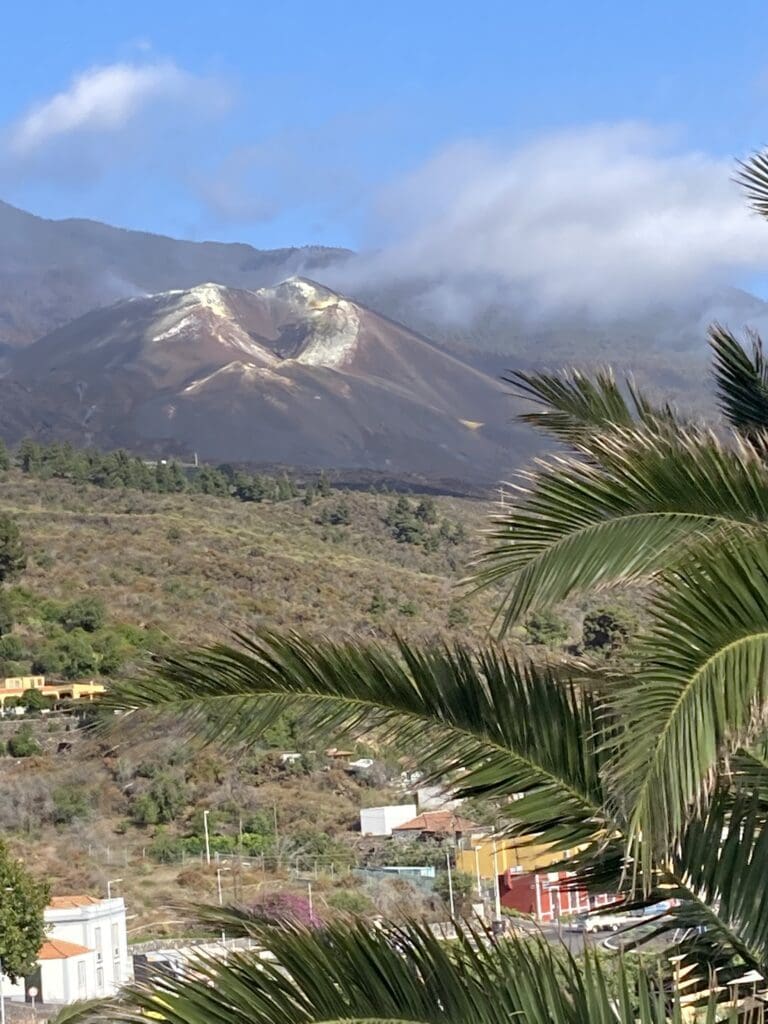
Len reported that they had a comfortable taxi and an informative driver. They were taken up very winding roads and tunnels through a national park. There were Canary pines everywhere. The driver travelled down the West side of the island to the viewing point for the volcano, which is still smoking, where they saw the devastation and the hardening lava running into the sea, forming a new island. They were told that it was 60 meters wide and 20 meters deep. On the way back, for variation, the guide/driver took them to the marina via the more traditional route. To top it off they discovered that he had a brother-in-law from Cork who taught English at the local college. The trip was very informative and gave them a good idea of the flora and fauna of the island as well as viewing the volcano.
Friday 1st of July
We were out of the bunks at 07.00 ready for the 60-mile passage to La Gomera. Moored outside the marina gate was a large car ferry. The view from our berth suggested that there was not room for Tortuga to leave but of course there was. When checking the chart plotter, before leaving the marina berth, I noticed that there was a ship approaching the harbour entrance. On calling the harbour authorities, Len was told Tortuga was not to leave for half an hour. Then the pilot, who was still ashore and about to go to bring the ship in called us and said we could leave immediately. I was happy about this because the wind speed was increasing making it more difficult to get out of our berth. I waited until I could see the ship approaching before setting the main at the harbour entrance. As we bore off for La Gomera the wind was 28 knots. After an hour it settled at 20 knots with waves of 1.5 meters. At about 22 miles out a school of dolphins that were very black in colour passed behind the stern. Tortuga entered the harbour of San Sebastian La Gomera at 17.45 hrs were the mariner sold us gate cards.
Saturday 2nd
After breakfast I went up to the office at 10.00 to check in as requested on our arrival. They have a wonderful system here with no forms to fill in. Everything is done digitally. Meanwhile Anne and Mary had a poor experience when the washing machine in the Laundry failed and locked their clothes inside. They were later recovered by the man who had checked me in so efficiently. Later after some shopping in the adjacent Spar we had dinner ashore. Len was the only one able to finish the huge helpings.
Sunday 3rd
At 09.00 our Len called the harbour authorities for permission to leave. Shortly after the mariner arrived and took back the gate cards, returned our deposit and cast us off. This is something I had never experienced anywhere else and is a great way of dealing with gate cards. We set the main just inside the harbour and as we sailed away from land, were in 33 knots of wind until Tortuga reached the shelter of Tenerife when the wind dropped to 10 knots and the sun was hot. For a moment Mary thought she was back in Greece again. As we entered the Marina Del Sur Las Galletas there was good help to reverse into the berth and no forms to fill out at check in, just payment in cash. The office was closed as it was Sunday.
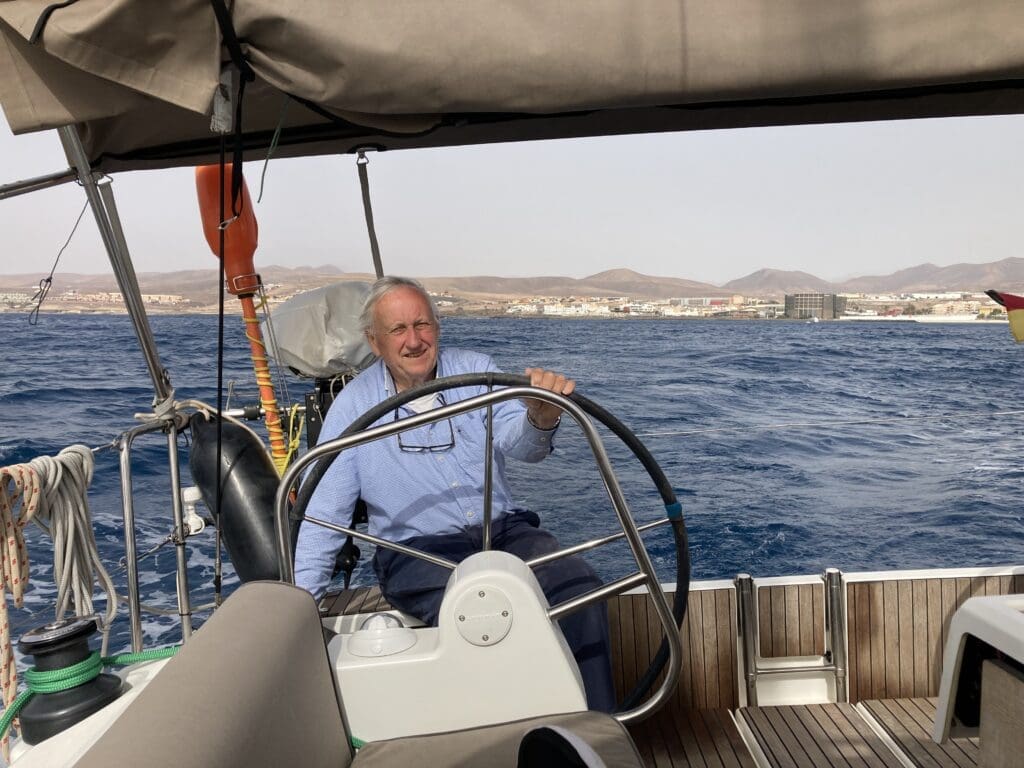
Monday 4th.
I got out of the bunk at 07.00 to return the gate card and recover our deposit but there was nobody about, so we left the berth at 07.45. The forecast for wind was 20 knots from the prevailing Northeast but as soon as we cleared the lee of Tenerife it blew 30 to 35 knots for 6 hours with lots of spray about and water from the deck flowing into the cockpit. Tortuga had no fiberglass upstand at the sprayhood so much of the water coming on deck made its way to there. She behaved impeccably, never broaching or giving us even a hint of anxiety. I sailed for the middle of Gran Carnaria until we were out of the gale in the shelter of the island and then turned South along the coast to enter Pasito Balanco at 18.00. Having such a wonderful crew in gale force winds for over six hours I thought it best that I treat them to dinner at the yacht club which everyone enjoyed. After the gale and a good dinner, all were looking forward to a rest day and slept well.
Tuesday 5th
I checked in, Len went to get bottled water while Anne and Mary went round to the Yacht Club for a swim to be told that facilities, other than dining, were for members only. We spend the afternoon relaxing aboard and had an early dinner as I planned a 04.00 start in the morning for the long passage to Fuerteventura.
Wednesday 6th
The alarm went off at 03.30 giving time for a cup of tea before our departure. I implemented my passage plan for this most difficult of our passages. It was to motor close to the coast of Grand Canaria for 4 hours and then bear away for the 50-mile crossing to Morro Jable, the nearest marina on Fuerteventura. As we turned North, I found we were motoring into gale force winds which we did for 2 hours before bearing away. As we close reached across between the islands the wind settled at 37 to 39 knots with 2-meter waves. Tortuga was perfect. At midday the wind eased to 28 knots until we entered what we thought might be the shelter of Fuerteventura at Point Jandia when it increased to 42 knots. Hilary Keatinge says, in the pilot Atlantic Islands, that sometimes it blows up to 50 knots approaching Morro Jable. We entered and berthed in the marina inside the harbour where it was almost windless.
Thursday 7th
Leaving Morro Jable next morning we were faced with wind on the nose East Northeast and a lumpy sea, so we motored the 18 miles to Point de Lantailla. Then as the wind went back to its usual direction into the Northeast, we motor sailed the final 34 miles to Rosario. The marina pontoons looked very new and there were plenty of available berths. Soon we saw a Customs officer walking down to us. He gave us 30 minutes to tidy up before I went with passports and the boats papers to his office. I had a great chat with him even though he didn’t speak much English and I don’t speak Spanish. He was unable to take cash, so I agreed to make a twenty-minute walk to the harbour office in the morning to settle the account.
Friday 8th
Anne joined me for a leisurely walk to the office. Rosario is a very beautiful city and the capital of Fuerteventura. We had plenty of time to explore as the passage to Marina Lanzarote is just 33 miles. As we had moored on a hammerhead, departure was quick and the passage back to base uneventful. We arrived at the fuel dock at 16.00 and I was happy that Lava’s skipper Jan came aboard and put Tortuga back in her berth. A very good service.
The chartering experience was positive with one exception. Shortly after leaving Marina Lanzarote, I noticed that Log and Depth sounder were not functioning. This was easily cured by Len and me in lifting the transducer and cleaning out the little crustations that had made a home there. Other than that, the service by Lava Charter was very good especially from Polish native Agata who contacted me just before our arrival, on WhatsApp, and was always available there. Later Agatha told me that the planned solution to our problem with the depth sounder and log was that Lava Charter would remove and plug transducers after the high winter season so crustations would have to find a different home when the yacht was not being sailed.

Saturday 9th
Before breakfast Mary and Len left for the airport and Cork and so ended an exhilarating 2-week cruise. With some help from the paper chart, when without a log, we sailed 610 miles taking in 6 of the seven major islands. We missed out on Isla De Hierro which we just did not have time for on this trip. If you enjoy sailing in plenty of wind, which I do, I strongly recommend summer off season cruising in the Canaries.
